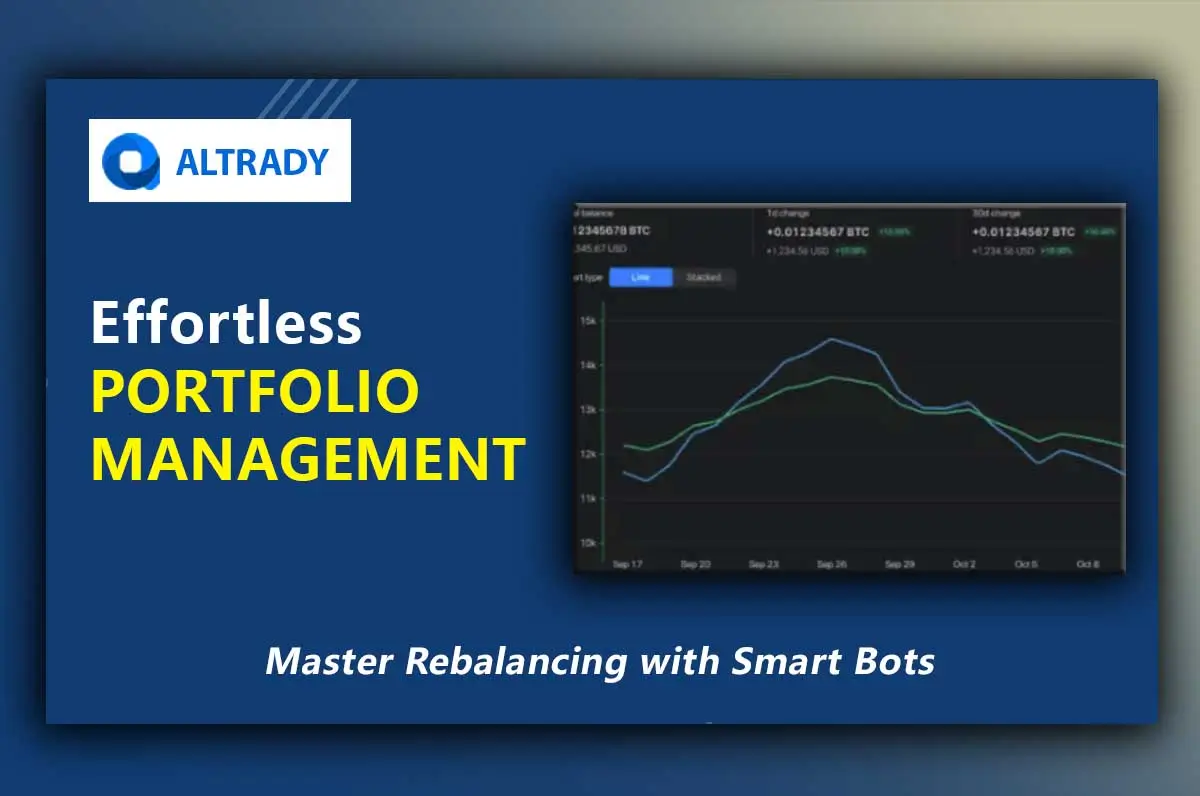Black Friday is loading…
Get 40% off with Altrady’s yearly plan and take the lead.
.svg)
.svg)
.svg)
.svg)
.svg)
.svg)
.svg)
.svg)
.svg)
.svg)
.svg)
.svg)
.svg)

Much like the fundamental principles of supply and demand that influence asset prices, the strategic distribution of assets within a portfolio and the mechanisms employed to maintain this distribution are elementary concepts for long-term success.
Among the sophisticated tools available, rebalancing bots have emerged as a powerful ally, automating the crucial process of maintaining a desired asset allocation and ensuring long-term portfolio success.

The concept of portfolio rebalancing is a factor to consider when aiming for sustained growth and risk mitigation in the crypto market. Asset prices may sharply fluctuate, causing the initial allocation of a portfolio to drift away from its intended proportions.
Typically, depending on the investor's risk tolerance and investment goals, a specific asset allocation is established. However, two scenarios emerge:
It is noteworthy to mention that the traditional approach to portfolio rebalancing often involves manual intervention, a process that can be time-consuming, emotionally exhausting, and prone to human error. For instance, consider the following situation:
The manual approach may present several challenges. The vast number of cryptocurrencies available and their rapid price fluctuations can make manual tracking and trading a cumbersome task.
Moreover, emotional biases can cloud judgment, leading investors to hold onto overperforming assets for too long or sell underperforming assets prematurely, potentially making it difficult to harvest long-term returns.
The optimal choice for a more efficient and disciplined approach lies in automation. Here is where rebalancing bots come to the forefront.
Discover: Crypto Portfolio - Track and Manage Your Crypto Investment
Rebalancing bots are automated trading tools designed to periodically adjust the asset allocation of a cryptocurrency portfolio back to its predefined target weights.
By connecting to cryptocurrency exchanges via Application Programming Interfaces (API technology), these bots can monitor portfolio holdings in real-time and execute trades automatically based on predefined rebalancing levels.
This algorithmic approach empowers traders and investors of any skill level to maintain their desired asset allocation consistently and efficiently, eliminating the need for constant manual monitoring and intervention.
The multi-exchange system furnishes an outstanding edge when implementing rebalancing strategies. In the context of a multi-exchange trading platform like Altrady, the integration of rebalancing bots can be particularly powerful.
By connecting multiple exchange accounts to Altrady, users can implement sophisticated rebalancing strategies across their entire portfolio from a single, unified interface. This is particularly beneficial in the cryptocurrency market, where price discrepancies and liquidity issues can sometimes arise between different exchanges.
The multi-exchange approach eliminates the need to manage rebalancing activities separately on each exchange, streamlining the process and enhancing efficiency.
Altrady's Smart Trading tools may further increase the capabilities of rebalancing bots, potentially offering advanced features for order execution and risk management during the rebalancing process.
Read: Building a 60-40 Portfolio Based on Quant Trading: Best Practices in Steve Cohen's Strategies
Let's point out some considerations regarding how these sophisticated tools operate.
The foundation of any rebalancing strategy lies in establishing a clear target asset allocation. Users define the desired percentage weight for each cryptocurrency within their portfolio.
For instance, a user might configure a bot with a target allocation of:
This allocation reflects their investment strategy and risk.
Rebalancing bots employ specific triggers to determine when an adjustment is necessary.
Two primary types of triggers are commonly used:
Once a rebalancing trigger is activated, the bot automatically executes the necessary trades to restore the target allocation.
These trades are typically executed using market orders for immediate fulfillment or limit orders to potentially achieve better prices.
There are some noteworthy benefits to leveraging the power of rebalancing bots for portfolio management:
Read: Understanding Risk to Survive Crypto Markets
To depict the practical application of rebalancing bots, consider the following example:
An investor sets a target allocation of 60% BTC and 40% ETH with a threshold-based rebalancing trigger of 5%.
If, after a period of market activity, BTC's weight increases to 66% and ETH's weight decreases to 34%, the rebalancing bot will automatically sell 6% of the BTC holdings
Then, use those funds to purchase an equivalent value of ETH, thus bringing the portfolio back to the desired 60/40 allocation.
Ultimately, portfolio management with rebalancing bots offers a sophisticated and efficient approach to maintaining equilibrium in the crypto market. By automating the process of adjusting asset allocations, these tools help investors stay disciplined, manage risk, and potentially enhance long-term returns.
As the cryptocurrency market continues to evolve, rebalancing bots are likely to become an integral component of effective portfolio management. Whether employing time-based or threshold-based rebalancing strategies, the use of bots can free up valuable time and remove emotional biases from investment decisions.
Altrady is a multi-exchange platform where bots play a critical role in managing portfolios. You can start implementing some of them in a free trial account with paper trading.